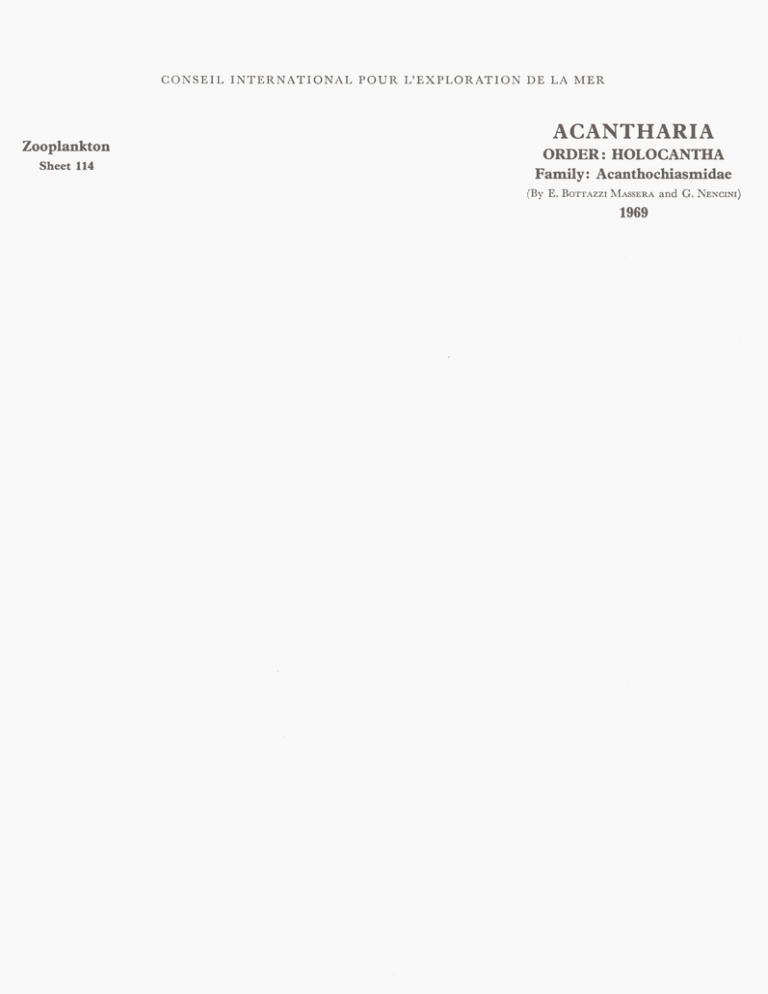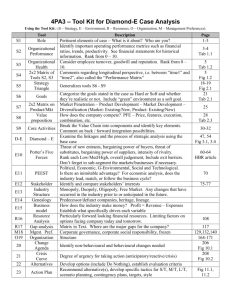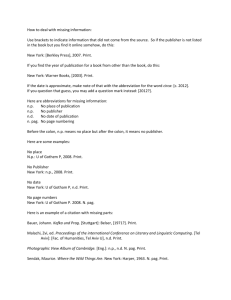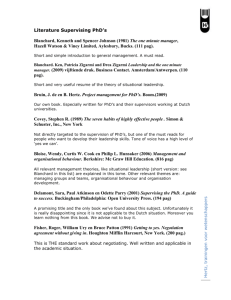ACANTHARIA plankton ORDER: HOLOCANTHA Family: Acanthochiasmidae
advertisement

C O N S E I L I N T E R N A T I O N A L P O U R L’EXPLORATION DE LA MER Zooplankton Sheet 114 ACANTHARIA ORDER: HOLOCANTHA Family: Acanthochiasmidae (By E.BOTTAZZI MASSERA and G. NENCINI) 1969 2 I 1 ' 100 p i 2 4 3 6 7 Figure 1. Acanthochiasma rubescens; Figure 2. A .fusiforme; Figure 3. A . serrulatum; Figure 4. A . planum; Figure 5. A . qwdrangulum; Figure 6 . A . hertuigi; Figure 7 . Acanthocyrta haeckeli. Figures 1, 2 and 7 modified after SCHEWIAKOFF; 3, 4, 5 and 6 original. 3 ACANTHARIA A c a n t h a r i a , marine planktonic Protozoa, are now separated from Radiolaria and are included in a distinct class. D i s t i n c t i v e c h a r a c t e r s : skeleton of celestite (SrS04) formed by a set of spiculae which always meet at the centre of the protoplasmatic body and are regularly arranged according to a fixed law (MULLER'S law); presence of a hydrostatic apparatus; lack of the perforated membrane. MULLER'S law: On comparing the roughly spheroidal of the Acantharia with a terrestrial globe, one may see that the emerging points of the spiculae are located in five parallel planes: 1 equatorial plane, 2 tropical planes and 2 polar planes. To be more specific: 1) two diametral or four radial spiculae on the Equator plane, arranged at 90' one with respect to the other (equatorial spiculae) ; 2) four diametral or eight radial spiculae inclined 30' on the equatorial plane; in projection, as seen from the pole, they form an angle of 45' with the preceding spiculae (tropical spiculae) ; 3) four diametral or eight radial spiculae inclined 60' on the equatorial plane; in projection, as seen from the pole, they become confused with the equatorial spiculae (polar spiculae). ORDER: HOLOCANTHA Ten diametral spiculae Family: ACANTHOCHIASMIDAE Spiculae which loosely cross in the centre or fit forming a more compact centre. Homogeneous gelatinous capsule. Absence of myonema. Genus: ACANTHOCHIASMA Haeckel p. p. Spiculae generally of equal shape and length, loosely crossed in the centre of the body. Ramified pseudopodia and non-ramified axopodia. 1. Acanthochiasma rubescens (Krohn). Thin cylindrical spiculae, of equal length and width. The.separation between ectoplasm and endoplasm little differentiated. Endoplasm with several concretions and few zooxantelles. Dimensions: length of spiculae: 0.8-1 .O mm, width of spiculae: 0.002-0.0025 mm. Diameter of protoplasmatic body: 0.24-0.35 mm. 2. Acanthochiasmafus;forme Haeckel. Short cylindrical spiculae, of the same length, enlarged in the central part and restricted in the distal parts. Ectoplasm and endoplasm differentiated. Endoplasm with few concretions and several zooxantelles. Dimensions: length of spiculae: 0.4-0.6, width of spiculae: 0.003-0.0035 mm. Diameter of protoplasm: 0.164.24 mm. 3. Acanthochiasma serrulatum Schewiakoff. Compressed spiculae, of the same length, pointed at the ends and with denticulated edges. Ectoplasm and endoplasm differentiated. Endoplasm with several concretions and without zooxantelles. Dimensions: length of the spiculae: 0.55-0.6 mm; width of the spiculae: 0.0025 mm. Diameter of protoplasm: 0.05-0.06 mm. 4. Acanthochiasma planum Popofsky. Compressed spiculae, of the same length, very thin in the central part, lanceolate in the distal parts. Dimensions: length of the spiculae: 0.1 1 mm, width of the spiculae in the apices: 0.0034 mm, in the middle: 0.002 mm. 5. Acanthochiasma quadrangulum Popofsky. Quadrangular spiculae, of the same length, thin in the central part, lanceolate in the distal parts. Dimensions: length of the spiculae: 0.9 mm, width of the spiculae in the apices: 0.007-0.008 mm and in the middle: 0.004mm. Diameter of the protoplasm: 0.15 mm. 6. Acanthochiasma hertwigi Popofsky. Quadrangular spiculae two of which longer than the other eight (6-7 times). The two main spiculae are thin in the central part and lanceolate in the distal parts. Dimensions: main spiculae length: 0.34 mm; width: in the apices 0.0048 mm, and in the middle 0.0017 mm. Secondary spiculae length: 0.051 mm, width: 0.001 mm. Genus: ACANTHOCYRTA Schewiakoff Spiculae of the same or of a different length, of the same or of a different shape, in the central part twisted like a spiral and gathered in a central body. Ramified or non-ramified pseudopodia, flagellum-shaped axopodia. 7. Acanthocyrta haeckeli Schewiakoff. One or two longer spiculae, stouter and differently shaped. The other spiculae cylindrical and point ended. Ectoplasm and endoplasm differentiated. Dimensions: length of the spiculae: 0.18-0.24 mm; width 0.002-0.003 mm. Main spiculae length: 0.3 mm; width: 0.004-0.006 mm. Diameter of the protoplasm: 0.11-0.14 mm. 4 Further Information on Identification Distribution 1. A . rubescens: HAECKEL, 1862, pag. 403-404; BRANDT,1885, pag. 208, 1887, pag. 739; POPOFSKY, 1904, Tab. 3, Fig. 2, 3, 7, 14; HAECKEL, pag. 51-52; POPOFSKY, 1906 b, pag. 349, Tab. 14, Fig. 2; MIELCK,1907, pag. 62; SCHEWIAKOFF,1926, pag. 64-69, Tab. 1, Fig. 1-2, Tab. 2, Fig. 1-2 e, 6-9, Tab. 4 Fig. 1-2. 1860, pag. 810; HAECKEL, 1862, pag. 404, 2. A . fusif.rme: HAECKEL, 1904, pag. 52; Tab. 19, Fig. 8; HAEC-L, 1887, pag. 739; POPOFSKY, 1906 b, pag. 350, Tab. 14, POPOFSKY, 1905 b, pag. 49, Fig. 2; POPOFSKY, Fig. 3; MIELCK, 1907, pag. 62-63; SCHEWIAKOFF, 1926, pag. 74-76, Tab. 2, Fig. 18, Tab. 4, Fig. 7-8. 3. A . serrulaturn: POPOFSKY,1906 b, pag. 352, Tab. 14, Fig. 10 as ? Ac. Bruhni; MIELCK, 1907, pag. 6 3 4 4 , Tab. 4, Fig. 2 a-6 as ? Ac. Bruhni; SCHEWIAKOFF, 1926, pag. 74-76, Tab. 2, Fig. 18, Tab. 4, Fig. 7-8. 4. A . planurn: POPOFSKY,1904, pag. 53-54, Tab. 4, Fig. 7; POPOFSKY, 1906 b, pag. 351, Tab. 14, Fig. 9; POPOFSKY, 1906 b, pag. 351, Tab. 14, Fig. 8 as Ac. plana var. Schotti; MIELCK,1907, pag. 69, Tab. 5, Fig. 1-2, Tab. 7, Fig. 7; SCHEWIAKOFF, 1926 pag. 76. 1904, pag. 54, Tab. 4, Fig. 4; SCHEWIA5. A . quadrangulum: POPOFSKY, KOFF, 1926, pag. 77. 6. A . hertwigi: POPOFSKY, 1904, pag. 54, Tab. 4, Fig. 5; MIELCK,1907, pag. 65; SCHEWIAKOFF, 1926, pag. 77. 7. A . haeckeli: POPOFSKY,1904, pag. 53, Tab. 4, Fig. 3 as ? Acanthochiasma 1920, decacanthurn; MIELCK,1907, pag. 65 as ? Ac. decacanthurn; HERTWIC, 1904, pag. 53, pag. 26, Tab. 2, Fig. 9 as ? Ac. decacanthum; POPOFSKY, 1926, pag. 79-82, Tab. 5, Fig. 1 as ? Ac. bicuspidatum; SCHEWIAKOFF, Tab. 3, Fig. 2, Tab. 4, Fig. 9-12, Tab.2, Fig. 19. Atlantic Ocean Species .. . Labrador Current. . . . . . . . . . . . . . . . . . . . . North Sea ............................... East Coast of America . . .. . . . . . . . a) Coastal area.. . . . . . b) Continental shelf. . . . . . . . . . . . . . . . . c) Continental slope. . . . . . . . . . . . . . . Gulf Stream. . . . . . . . . . .. . . . . . . . . . . Southern Edge of Gulf Stream.. . . . . . . . . . . . Northern Edge of Gulf Stream.. . . . . . . . . . Sargasso Sea . . . . . . . . . . . . . . . . . . . . . . . . Northern Sargasso Sea. . . . . . . . . . . . . . . . . . . Southern Sargasso Sea. . . . . . . . . . . . . . . . . . . Western Sargasso Sea. . . . . . . . . . . . . . . . . . . . . North Equatorial Current . . . . . . . . . . . . . . . . . South Equatorial Current. . . . . . . . . . . . . . . . . Equatorial Counter Current. . . . . . . . . . . . . Canaries Current. . . . . . . . . . . . . . . . . . . . . . . . Antilles Current. . . . . . . . . . . . . . . . . . . . . . . . . Caribbean Sea ........................... Guyanas Current . . . . . . . . . . . . . . . . . . . . . . . South Atlantic Gyre, feeding into Guyanas Current ............................... . . .. .. .. . .. . . . ... .. . . .. .. .. . . .. . . . Mediterranean Sea Ligurian Sea ............................ 1,297 Tyrrhenian Sea. . . . . . . . . . . . . . . . . . . . . . . . . . 192, 3, 7 REFERENCES BRANDT,K., 1905. Zool. J. Suppl., 7: 311-52. O., 1906. Zool. Anz., 30: 784-89. BUETSCHLI, CLEVE,P. T., 1899. K. svenska Vetensk. Akad. Handl., 32. CLEVE,P. T., 1900. K. svenska Vetensk. Akad. Handl., 34. GRASSB,P., 1953. Trait6 de Zoologie, 1, fasc. 11. HAECKEL, E., 1862. “Die Radiolarien. Eine Monographie”. Berlin. HAECKEL, E., 1887. “Report on the Radiolaria collected by H. M. S. “Challenger” during the years 1873-1876”. 716-888; London. HAECKEL, E., 1888. “Die Radiolarien”. 3. Teil Berlin. MASSERA, E. BOTTAZZI, 1963. Boll. Zoll., 30: 1-7. MASSERA,E. BOTTAZZI, 1964. Boll. Zool., 31: (2) 1115-23. MASSERA, E. BOTTAZZI, NENCINI, G. and VANNUCCI, A., 1965. Boll. Pesca Piscic. Idrobiol., 20: (1) 9-20. MASSERA,E. BOTTAZZIand VANNUCCI, A., 1964. 1st Contribution. Archo Oceanogr. Limnol. Venezia, 13: 315-85. MASSERA, E. BOTTAZZI, 1964. Atti Soc. ital. Sci. nat., 103: (4) 375. MASSERA, E. BOTTAZZI and VANNUCCI, A., 1965. 2nd Contribution. Archo Oceanogr. Limnol. Venezia, 14: (1) 1-68. MASSERA, E. BOTTAZZI and VANNUCCI, A., 1965. 3rd Contribution. Archo Oceanogr. Limnol. Venezia, 14: (2) 153256. MASSERA, E. BOTTAZZI, 1965. Atti Soc. ital. Sci. nat., 104: (3) 318. MASSERA, E. BOTTAZZI and VINCI,A., 1965. Acta naturalia, Ateneo Parmense, 1: (1) 3. MASSERA, E. BOTTAZZI, 1966. Acta naturalia, Ateneo Parmense, 1 (12). MIELCK, W., 1907. Wiss. Meeresunters. Abt. Kiel, N.F. 10: 39-105. MULLER,J., 1858. Abh. preuss. Akad. Wiss. Math-Naturw. Kl., 1: 1 4 2 . ODUM,H.T.,1951. Science, N.Y., 114: 211-12. POPOFSKY, A., 1904. Ergebn. Atlant. Ozean Planktonexped. T. 1 Acanthometra, 3 L.f.S., 1-158pp. POPOFSKY,A., 1905. Arch. Protistenk, 5: 340-57; Tables 1415. POPOFSKY, A., 1905. “Teil 1. Acanthometriden”. Nord, Plankt. 3: 43-69. POPOFSKY, A., 1906. “Die Acanthophractiden”. Ergebn. Atlant. Ozean Planktonexped. Humboldt-Stift., 3 L.f.S., 1-160 pp. POPOFSKY, A., 1906. Arch. Protistenk. 7: 345-94. SCHEWIAKOFF, W., 1902. Zool. Anz. 30: 784. SCHEWIAKOFF, W., 1926. Fauna Flora Golfo Napoli, 37. SCHREIBER,B.,CAVALCA,L.and BOTTAZZIMASSERA,E. 1959. Boll. ZOO^., 26: (2) 213-19. SCHREIBER, B., BOTTAZZI MASSERA, E., FANOSCHREIBER, A., GUERRA, F. and F’ELATI,L., 1962. Pubbl. Staz. zool. Napoli, 32: (suppl.) 400-26. TREGOUBOFF, G. and ROSE,M., 1957. “Manual de Planctonologie mCditerrantenne”. Paris, C.N.R.S.





